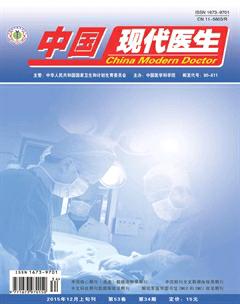超声联合CT诊断甲状腺乳头状癌颈淋巴结转移的临床价值
张毅 董剑达 季敬章 郑志强

[摘要] 目的 探讨超声(ultrasound,US)联合计算机断层扫描(computed tomography,CT)对甲状腺乳头状癌颈淋巴结转移的临床诊断价值。 方法 选取2013年6月~2015年6月在我院行甲状腺癌手术治疗、术后病理证实为甲状腺乳头状癌98例,术前均行颈部B超和CT检查,术后行HE染色、组织病理检查,进行相互比较。 结果 根据“每水平”分析,US/CT与US相比能显著提高颈侧区和颈总区转移淋巴结的检测准确度(P=0.032,P=0.028);US/CT与CT相比并未能显示出优越的诊断价值(P>0.05)。根据“每人”分析,US与CT的准确率比较差异无统计学意义(P>0.05);US/CT与US之间的准确率比较差异有统计学意义(P=0.047);而US/CT与CT之间的准确率比较差异无统计学意义(P>0.05)。影像学预测转移组与未转移组准确率对比,差异有统计学意义(P<0.05)。 结论 US/CT对PTC患者颈侧区转移淋巴结的检测优于US,对术前US怀疑有颈侧区淋巴结转移者,可进一步行CT检查,以决定是否行颈侧区淋巴结清扫。
[关键词] 甲状腺乳头状癌;淋巴结转移;超声;计算机断层扫描
[中图分类号] R576 [文献标识码] B [文章编号] 1673-9701(2015)34-0092-04
Clinical value of combined ultrasound and CT for detecting cervical metastatic lymph nodes in patients with papillary thyroid carcinoma
ZHANG Yi1 DONG Jianda1 JI Jingzhang2 ZHENG Zhiqiang1
1.Department of General Surgery, the Second Affiliated Hospital of Wenzhou Medical College, Wenzhou 325000, China; 2.Wenzhou Medical College, Wenzhou 325000, China
[Abstract] Objective To explore the value of ultrasonography and CT in diagnosis of the cervical lymph nodes metastasis of thyroid carcinoma. Methods From June 2013 to June 2015, 98 cases of thyroid cancer patients were selected as the research object patients, who confirmed as papillary thyroid carcinoma by pathology. All patients were evaluated by ultrasonography and CT examination before surgery. And then examined by pathologicl HE staining and pathology method after operation. Results The accuracy of detection of metastatic nodes by US/CT was higher than By US at the level of central and lateral neck with “per level” analysis (P=0.032 and P=0.028). Detected by US/CT was no significant difference of diagnostic values than by CT. With “per person” analysis, there were no significant differences of accuracy between US and CT or between US/CT and CT (P>0.05). Compared with the group without metastasis, the accuracy of the imaging prediction was statistically significant(P<0.05). Conclusion US/CT combination is found to be superior to US alone for the detection of cervical metastatic lymph nodes in lateral neck levels in PTC patients. Preoperative CT should be used in some PTC patients with suspected node metastasis by US, and to determine whether the lateral compartment dissection is needed.
[Key words] Papillary thyroid carcinoma; Lymph nodes metastasis; Ultrasound; CT
甲状腺乳头状癌(papillary thyroid carcinoma,PTC)是甲状腺最为常见的恶性肿瘤,约占所有甲状腺癌的80%[1-4],颈淋巴结转移是PTC最主要的转移方式,目前对颈淋巴结阳性(cN+)病例实行联合根治手术已无异议,但对临床颈淋巴结阴性(cN0)的病例,是否实行颈部淋巴结清扫以及清除范围、时机等问题国内外均存在争议。超声是目前术前评估甲状腺癌淋巴结转移情况的首选方法[5],然而大部分这些报道主要根据“每人”的视角,而不是以“每水平”为基础作分析研究[6-9]。本实验通过比较甲状腺乳头状癌颈部淋巴结转移的B超和CT的表现,探讨B超联合CT对甲状腺乳头状癌颈淋巴结转移的临床诊断价值,现报道如下。
1 资料与方法
1.1 一般资料
选取2013年6月~2015年6月在我院行手术治疗的术前诊断甲状腺癌患者98例,经术后病理诊断证实均为甲状腺乳头状癌,所有患者在本次手术前未接受过颈部淋巴结切除或颈部淋巴结清扫术。患者依据彩超及CT检查中1项及以上提示有颈淋巴结转移者为转移组共52例,其中男24例,女28例;中位年龄38.4岁(15~67岁)。肿瘤部位:左侧23例,右侧27例,双侧2例;其中包膜内型7例,腺内型32例,腺外型13例。
1.2 方法
1.2.1 超声检查 采用ALOKA SSD-2000型、GE VIVID-3型彩色多普勒超声诊断仪。探头频率7.5~13.3 MHz。淋巴结转移超声诊断标准:局部或弥漫性高回声;细小或粗大钙化;囊性变;近圆形(长短径<1.5)[10-13]。
1.2.2 CT检查 使用Siemens 16层螺旋CT机,平扫加增强,增强造影剂选用德国拜耳医药公司的优维显370,60~85 mL(2~2.8)mL/s静脉推注,层厚为1~3 mm,扫描范围从乳突水平至胸骨切迹水平行颈部扫描。同样按颈部淋巴结分区记录淋巴结的部位、大小、数目及CT的影像特点。淋巴结转移CT诊断标准:强化明显而淋巴门血管不强化;环形强化或伴不均匀强化;细小或粗大钙化;囊性变或坏死[14,15]。淋巴结均匀强化和淋巴结门血管强化被认为反应性增生。淋巴结大小标准不被采用,因为尚没有建立PTC转移性淋巴结的大小标准[16-18]。
1.2.3 病理检查 采用1991年美国耳鼻咽喉头颈外科学会颈部淋巴结分区判断阳性淋巴结。手术中颈清扫标本被整块切除后,由手术者按解剖标志分为Ⅱ、Ⅲ、Ⅳ、Ⅴ、Ⅵ区等5块组织并分别标识。由病理科医生对被标识标本进行取材,获取淋巴结并观察、计数,报告标本中淋巴结的数量及转移淋巴结在各区的分布。
1.3 判断标准
将术前超声、CT结果与术后病理检查进行“区-区”对照比较(即“每水平”分析)和“人-人”对照比较(即“每人”分析),判断超声、CT、以及联合检查对PTC颈淋巴结转移的诊断准确性。
1.4 统计学分析
采用SPSS19.0统计软件学进行数据分析,率的比较采用χ2检验。P<0.05为差异有统计学意义。
2 结果
转移组CT、US检查显示淋巴结转移见图1,2,共52例患者,术后病理证实均为甲状腺乳头状癌,其中单侧颈清(Ⅱ~Ⅵ)50例,双侧颈清(Ⅱ~Ⅵ)2例,共行颈清54侧,获颈淋巴结灶区标本234个,其中转移性淋巴结区143个(53%)。
2.1 “每水平”分析US、CT和US/CT的诊断准确性
根据“每水平”分析,US、CT和US/CT在中央区的诊断准确度为50.0%、57.9%、60.5%,在颈侧区为58.2%、77.0%、79.1%,总颈水平为56.8%、73.9%、76.1%。在中央区、颈侧区和颈总区US和CT的诊断结果没有统计学差异(P>0.05);与US相比,US/CT能显著提高颈侧区和颈总区转移淋巴结的检测准确度(P=0.032和P=0.028);与CT相比,无论在中央区还是颈侧区US/CT并未能显示出优越的诊断价值(P>0.05)。见表1。
表1 “每水平”分析US、CT和US/CT的诊断准确性
注:#*与US/CT相比;准确度=术后病理诊断阳性例数/预测淋巴结转移阳性例数×100%
2.2 根据“每人”分析
转移组52例患者中经术后病理确诊转移的31例,准确率59.6%,其中彩超提示42例,病理确诊20例,准确率52.3%;CT提示40例,病理确诊28例,符合率70%;彩超和CT同时提示31例,病理确诊28例,准确率87.5%。彩超与CT检查的准确率差异无统计学意义(χ2=0.002,P=0.553),彩超联合CT同时检查的符合率与彩超单独检查的准确率之间差异有统计学意义(χ2=2.421,P=0.047)。彩超联合CT同时检查与CT单独检查的准确率之间差异无统计学意义(χ2=2.076,P=0.082)。未转移组患者按本院治疗常规未行预防性侧颈清除术,至随诊截止,本组共12例发生经病理确诊的颈部淋巴结转移。转移组与未转移组对比,两组之间的准确率比较差异有统计学意义(χ2=4.471,P=0.026)。
3 讨论
目前国内外对PTC患者是否行颈淋巴结清扫以及清扫的范围等尚存在争议,争论的焦点主要集中在对颈侧区淋巴结的处理上。因此术前准确评估颈淋巴结转移情况非常重要,直接影响到治疗决策,决定手术成败。US是目前评估甲状腺结节和颈淋巴结的重要影像学检查手段[19,20],本研究发现淋巴结内钙化和液性暗区时淋巴结转移具有非常特异性表现。但由于US的主观依赖性强,对咽后、纵隔、部分低位Ⅵ区淋巴结检查受限,一定程度上影响US的应用。本研究发现淋巴结内钙化、增强扫描时出现环形强化和不均匀强化以及液性暗区时具有非常明显的特异性。
CT相比较US而言,具有以下优点:如不依赖于操作者,可对整个颈部进行全面评估,而薄层1~3 mm的扫描更不易遗漏小病灶[21]。本研究结果表明,根据“每水平”对照分析,在PTC患者术前颈淋巴结评估中,US/CT联合检测在颈侧区诊断方面优于单独的US;而在颈中央区,US/CT与US的诊断准确度无明显差异。因此根据我们的研究结果,US/CT联合检测有助于提高颈侧区和颈总水平的诊断。
在本实验中,尽管CT的诊断准确度没有US高,但US/CT在诊断颈侧区淋巴结方面具有显著的优势。结果显示,在PTC患者的术前淋巴结评估中,CT对US有补充作用。相比较单独的US而言,US/CT的诊断敏感度更高,其原因可能解释为:US和CT对转移性淋巴结的影像学诊断特点不同,减少了操作者的主观误差(漏诊),对全颈水平进行整体评估,包括US有时候难以发现的低位Ⅵ和高位Ⅱ区;同时,CT可有助于增加US对非特异性转移淋巴结的诊断信心,如体积较大、淋巴门消失、圆形或US形态有怀疑者。由于US/CT较US能发现更多的颈侧区转移淋巴结,所以有可能改变原定的手术计划,最终使患者受益。因此,我们认为CT有助于US对部分PTC患者的术前评估。
总之,通过对PTC患者术前颈淋巴结的“每水平”比较分析,US/CT比单独US在颈侧区诊断方面更具有优势,CT可为评估PTC患者淋巴结转移提供有用的诊断价值。
[参考文献]
[1] Mazzaferri EL,Jhiang SM. Long-term impact of initial surgical and medical therapy on papillary and follicular thyroid cancer[J]. Am J Med,1994,97(5):418-428.
[2] Lebastchi AH,Callender GG. Thyroid cancer[J]. Curr Probl Cancer,2014,38(2):48.
[3] Mutlu H,Sivrioglu AK,Sonmez G,et al. Role of apparent diffusion coefficient values and diffusion-weighted magnetic resonance imaging in differentiation between benign and malignant thyroid nodules[J]. Clinical Imaging,2012, 36(1):1-7.
[4] So YK,Son YI,Hong SD,et al. Subclinical lymph node metastasis in papillary thyroid microcarcinoma:A study of 551 resections[J]. Surgery,2010,148(3):526-531.
[5] Cooper DS,Doherty GM,Haugen BR,et al. Tuttle RM 2006 management guidelines for patients with thyroid nodules and differentiated thyroid cancer[J]. Thyroid,2006,16(2):109-142.
[6] Kouvaraki MA,Shapiro SE,Fornage BD,et al. Role of preoperative ultrasonography in the surgical management of patients with thyroid cancer[J]. Surgery,2003,134(6):946-954.
[7] Stulak JM,Grant CS,Farley DR,et al. Value of preoperative ultrasonography in the surgical management of initial and reoperative papillary thyroid cancer[J]. Arch Surg,2006, 141(5):489-494.
[8] Molinari F,Mantovani A,Deandrea M,et al. Characterization of single thyroid nodules by contrast-enhanced 3-D ultrasound[J]. Ultrasound in Medicine & Biology,2010,36(10):1616-1625.
[9] Koo BS,Lim HS,Lim YC,et al. Occult contralateral carcinoma in patients with unilateral papillary thyroid microcarcinoma[J]. Annals of Surgical Oncology,2010,17(4):1101-1105.
[10] Rosario PW,de Faria S,Bicalho L,et al. Ultrasonographic differentiation between metastatic and benign lymph nodes in patients with papillary thyroid carcinoma[J]. J Ultrasound Med,2005,24(10):1385-1389.
[11] Ying M,Ahuja A,Metreweli C. Diagnostic accuracy of sonographic criteria for evaluation of cervical lymphadenopathy[J]. J Ultrasound Med,1998,17(7):437-445.
[12] Na DG,Lim HK,Byun HS,et al. Differential diagnosis of cervical lymphadenopathy:Usefulness of color Doppler sonography[J]. Am J Roentgeno,1997,168(5):1311-1316.
[13] Kwak JY,Kim EK,Kim HJ,et al. How to combine ultrasound and cytological information in decision making about thyroid nodules[J]. European Radiology,2009,19(8):1923-1931.
[14] Som PM,Brandwein M,Lidov M,et al. The varied presentations of papillary thyroid carcinoma cervical nodal disease:CT and MR findings[J]. Am J Neuroradio,1994, 15(6):1123-1128.
[15] Seiberling KA,Dutra JC,Grant T,et al. Role of intrathyroidal calcifications detected on ultrasound as a marker of malignancy[J]. The Laryngoscope,2009,114(10):1753-1757.
[16] Kim E,Park JS,Son KR,et al. Preoperative diagnosis of cervical metastatic lymph nodes in papillary thyroid carcinoma:comparison of ultrasound,computed tomography, and combined ultrasound with computed tomography[J]. Thyroid,2008,18(4):411-418.
[17] Yasui J,Shimizu T,Ando T,et al. Successful visualization of an indeterminate hepatic metastasis from thyroid carcinoma using contrast-enhanced CT and contrast-enhanced ultrasound[J]. J Clin Endocrinol Metab,2013,98(7):2639.
[18] Roh JL,Park CI. Sentinel lymph node biopsy as guidance for central neck dissection in patients with papillary thyroid carcinoma[J]. Cancer,2008,113(7):1527-1531.
[19] 姚洁洁,詹维伟. 超声检查对甲状腺癌术后复发、转移的评估[J]. 外科理论与实践,2013,18(5):454.
[20] Bilimoria KY,Bentrem DJ,Ko CY,et al. Extent of surgery affects survival for papillary thyroid cancer[J]. Annals of Surgery,2007,246(3):375-381.
[21] Kurata S,Ishibashi M,Hiromatsu Y,et al. Diffuse and diffuse-plus-focal uptake in the thyroid gland identified by using FDG-PET:Prevalence of thyroid cancer and Hashimotos thyroiditis[J]. Annals of Nuclear Medicine,2007,21(6):325-330.
(收稿日期:2015-08-17)

